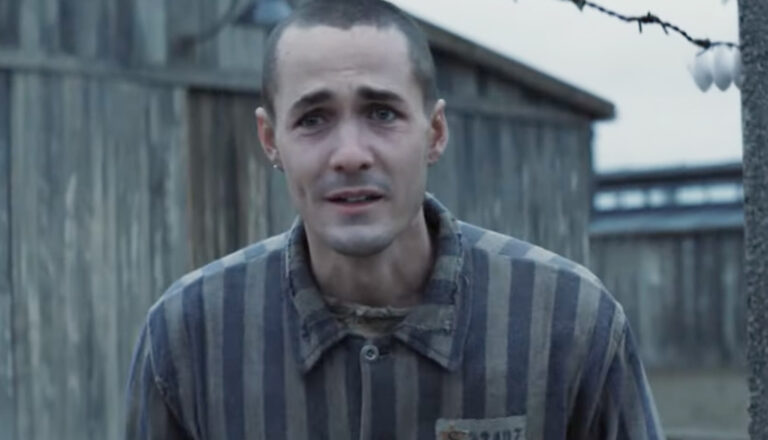
A Man in Full
Talent and intrigue ultimately can’t cloak the truth about this vulgar, crass and graphic drama on Netflix.

Glenda Cleveland knew something was wrong in the apartment next door. She knew it from the smell. The sounds. The occasional screams.
She called the Milwaukee police, but no one came. They never came.
No, that’s not quite right: When a teen escaped the apartment, naked and bleeding, the cops came. But they just walked the boy back to the apartment, in the care of the man who said he was his lover. They filed the report under “domestic dispute.”
Yes, the officers noticed the stench, too. The cops thought nothing of it: the smell of excrement, they believed.
They didn’t bother to inspect the apartment. Otherwise, they would’ve found a decomposing body, then three days dead. And the teen—14-year-old Konerak Sinthasomphone—soon became another victim. He was never seen alive again.
Konerak became one of 17 victims of the real Jeffrey Dahmer, whose crimes made headlines in 1991.
The Netflix series Dahmer (referred to also as Monster: The Jeffrey Dahmer Story) chronicles the serial killer’s life (including flashing back to critical periods when he himself was young) and his grisly deeds. It apparently sticks reasonably close to the facts, albeit with some notable departures. (The real-life Glenda Cleveland, for instance, actually lived in an adjacent building, not an adjacent apartment unit.)
But while the core story is indeed monstrous, some of the changes seemed to be designed to augment another underlying narrative the movie’s makers wish to emphasize. Namely, the way law enforcement—disinterested (the miniseries alleges) in protecting gays and minorities—abetted Dahmer’s murder spree.
As the series unfolds, we can see that law enforcement deserves no small amount of blame in the real Dahmer case. But producer Ryan Murphy—creator of Glee and American Horror Story—seemingly argues that another monster was at work in the Dahmer story, and he muddies the facts to make it clear.
The series opens, for instance, with Cleveland watching a news story about five white Milwaukee police officers beating a Black undercover officer on assignment. (The Milwaukee Journal Sentinel couldn’t find a record of such a crime in the days leading up to Dahmer’s arrest.) Another instance: The show alleges that the two officers who returned Sinthasomphone to Dahmer’s custody later received “Officer of the Year” commendations. Never happened, the Journal Sentinel says, though both were eventually reinstated in their jobs after being suspended.
But those small factual adjustments are not nearly as controversial as this one central issue: that this show exists at all.
Everyone loves a good serial killer.
Oh, sure, we’re supposed to hate serial killers. And I suppose on some level we do. But we also can’t get enough of them. Netflix’s miniseries is the 20th movie or television treatment of Jeffrey Dahmer (albeit most of those were straight-up documentaries). And for those intimately attached to the real-life crimes, enough is enough.
One relative of a Dahmer victim tweeted his displeasure. “It’s retraumatizing over and over again, and for what?” he wrote. “How many movies/shows/documentaries do we need?” Another relative, Rita Isabell, told the Today show, “It’s sad that they’re just making money off of this tragedy. That’s just greed.”
Of course, it’d be a nonissue if we, the viewing public, would just stop watching such shows. (Indeed, true crime movies, shows, documentaries and podcasts are among the most popular stories in our culture right now.) Perhaps then Netflix and others would stop making them. But viewers also are complicit. Upon its release, Dahmer quickly became the streaming giant’s No. 1 show. And while critics have given the limited series a tepid 50% “freshness” rating on Rotten Tomatoes, audiences have pinned it at 87%.
Personally, I have a hard time understanding how anyone could’ve even finished the show to rate it.
The Netflix show isn’t as graphic as it could’ve been, considering the almost unbelievable atrocities involved. But this is still a show anchored to murder, dismemberment, necrophilia and cannibalism. And while it doesn’t document every removed appendage, every acid-eaten torso, it shows and tells enough to keep its viewers squirming … and hooked.
Because Dahmer lured gay men and teen boys into his apartment, we see plenty of homosexual interactions and discussions. (The show suggests that Dahmer counted on the police department’s squeamishness over homosexuality deterring them from probing allegations further. In the very first episode, he discourages police from searching his bedroom because “there’s a bunch of gay stuff in there.”) Sex is a part of the plot, and brief nudity is seen.
Foul language is a huge issue, as well. Dahmer and his victims drink, and he normally drugs them too before his atrocities commence.
Listen, I see a lot of difficult-to-watch, content-laden shows for my job. But Dahmer pushed me to the edge. What we see and hear on screen is bad enough. To know, though, that the story was depicting the horrific deaths of real people, stretching their narratives over agonizingly long stretches of time, well, just one episode was enough for me. Far more than enough.
I’d agree with the tweeter quoted above: So much trauma regurgitated in torturous, salacious detail, and for what? To me, there’s something inherently prurient at work here—a story that depends on the worst parts of us to watch.
The fact that such a thing happened once is an unimaginable tragedy. I don’t need to see it again.
As Glenda Cleveland ponders the worrisome smell coming out of Jeffrey Dahmer’s apartment, Jeff himself goes out searching for a new victim. He finds one at a gay bar: Tracy Edwards. He invites the man back to his place, offering to pay him $50 to take some “artistic” pictures of him. But when Jeff gets him to the apartment and slaps a pair of handcuffs on his guest—and when Tracy sees a massive bloodstain on a mattress and a mysterious vat in the bedroom corner—the would-be model realizes that his very life might be in danger.
Tracy tries to buy time/explore escape options by distracting Jeff with the promise of sex. He dances for Jeff and strips off his shirt. He sucks on Jeff’s index finger. Jeff tells Tracy that he wants to hear his heart beat, so Tracy lets Jeff rest his head on his chest. “I want to hear your heart,” Jeff tells him. “Because I’m gonna eat it.”
The killer’s apartment contains dozens of Polaroid pictures apparently showing victims in states of undress and dismemberment. (We see a few of those pictures suggesting nudity, blood and mutilation, but anything specific is largely obscured.) Police discover a severed head in the refrigerator (which we catch a glimpse of), and baggies containing human hearts and genitals (the latter unrecognizable in the frost-encrusted bag). Some gelatinous-looking meat is found in a vat of acid in the bedroom. (We’re told it’s human torsos). Skulls are also discovered.
From Glenda’s apartment, we hear the sounds of power tools being used, and we see Jeff wash both his blood-covered arms and tools. He threatens Tracy with a knife. Someone has their eyes gouged, and there’s a fight in the apartment.
Jeff talks to three men at the gay bar, all of whom talk openly about their sexual orientation and ask him if he’s actually going to make a “move” on any of them. We see glimpses of some provocative pictures on Jeff’s apartment walls. He drinks beer and other alcoholic beverages. He smokes as well. He offers Tracy a beer spiked with drugs.
Tracy sees the Satanic Bible on Jeff’s nightstand. Jeff forces Tracy to watch The Exorcist III, a movie that the killer says he watches every day. (We see some scenes from the movie featuring priests and demons.)
A dozen f-words (several paired with “mother”) are uttered. We also hear the s-word three times, “b–ch,” “h—” and “g-dd–n.”


Paul Asay has been part of the Plugged In staff since 2007, watching and reviewing roughly 15 quintillion movies and television shows. He’s written for a number of other publications, too, including Time, The Washington Post and Christianity Today. The author of several books, Paul loves to find spirituality in unexpected places, including popular entertainment, and he loves all things superhero. His vices include James Bond films, Mountain Dew and terrible B-grade movies. He’s married, has two children and a neurotic dog, runs marathons on occasion and hopes to someday own his own tuxedo. Feel free to follow him on Twitter @AsayPaul.

Talent and intrigue ultimately can’t cloak the truth about this vulgar, crass and graphic drama on Netflix.

Tales of the Empire is typical Star Wars fare. But in its exploration of what drives folk to the Dark Side, it can get a bit…darker.

The Tattooist of Auschwitz is a little like its titular character. It’s painful. It gets under your skin. And it just might leave a mark.

The Sonic spinoff blends explosive adventure and road-trip-buddy-comedy into a fun romp for both kids and diehard fans.